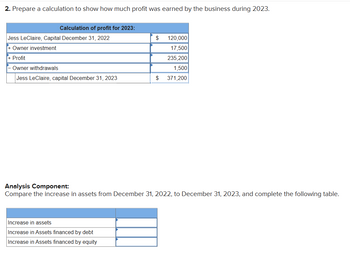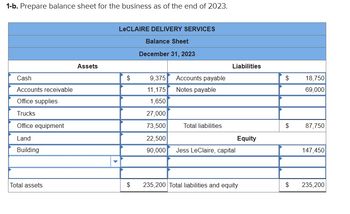The accounting records of LeClaire Delivery Services show the following assets and liabilities as of the end of 2023 and 2022: Cash Accounts receivable. Office supplies Trucks Office equipment Land Building Accounts payable Notes payable December 31 Cash Accounts receivable Office supplies Trucks 2023 2022 $9,375 $26,250 11,175 14,250 1,650 2,250 27,000 27,000 69,000 Assets 73,500 22,500 90,000 18,750 52,500 During December 2023 the owner, Jess LeClaire, purchased a small office building and moved the business from rented quarters to the new building. The building and the land it occupies cost $112,500. The business paid $60,000 in cash and a note payable was signed for the balance. LeClaire had to invest $17,500 cash in the business to enable it to pay the $60,000. The business earned a Profit during 2023, which enabled LeClaire to withdraw $1,500 per month from the business for personal expenses. Required: 1-a. Prepare balance sheet for the business as of the end of 2022. 3,750 LeCLAIRE DELIVERY SERVICES $ Balance Sheet December 31, 2022 26,250 Accounts payable 14,250 2,250 27,000 Liabilities Equity $ 18,750
The Effect Of Prepaid Taxes On Assets And Liabilities
Many businesses estimate tax liability and make payments throughout the year (often quarterly). When a company overestimates its tax liability, this results in the business paying a prepaid tax. Prepaid taxes will be reversed within one year but can result in prepaid assets and liabilities.
Final Accounts
Financial accounting is one of the branches of accounting in which the transactions arising in the business over a particular period are recorded.
Ledger Posting
A ledger is an account that provides information on all the transactions that have taken place during a particular period. It is also known as General Ledger. For example, your bank account statement is a general ledger that gives information about the amount paid/debited or received/ credited from your bank account over some time.
Trial Balance and Final Accounts
In accounting we start with recording transaction with journal entries then we make separate ledger account for each type of transaction. It is very necessary to check and verify that the transaction transferred to ledgers from the journal are accurately recorded or not. Trial balance helps in this. Trial balance helps to check the accuracy of posting the ledger accounts. It helps the accountant to assist in preparing final accounts. It also helps the accountant to check whether all the debits and credits of items are recorded and posted accurately. Like in a balance sheet debit and credit side should be equal, similarly in trial balance debit balance and credit balance should tally.
Adjustment Entries
At the end of every accounting period Adjustment Entries are made in order to adjust the accounts precisely replicate the expenses and revenue of the current period. It is also known as end of period adjustment. It can also be referred as financial reporting that corrects the errors made previously in the accounting period. The basic characteristics of every adjustment entry is that it affects at least one real account and one nominal account.

Step by step
Solved in 3 steps











